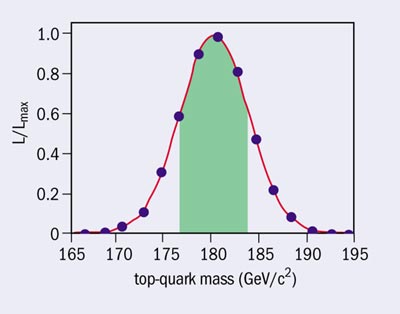
The D0 collaboration at Fermilab has applied a new technique for measuring the mass of the top quark that yields a more precise result than previously. The new result affects constraints on the mass of the Higgs boson, increasing slightly the most likely value of its mass.
In the D0 experiment pairs of top quarks and antiquarks – ttbar – are produced in head-on proton-antiproton collisions in the Tevatron. The t (tbar) swiftly decays to a bottom quark, b (bbar), and a W+(W–) boson. In this new analysis the team has re-examined events from Run I in which one of the W particles decays into a charged lepton (electron or muon) and a neutrino, while the other decays into a quark and an antiquark. The new technique is based on ideas developed several years ago by Kunitaka Kondo at Waseda University in Japan, and independently by Richard Dalitz and Gary Goldstein at Oxford. The method gives more weight to well measured events and allows more information to be extracted from each event. Basically, the team calculates as a function of the top mass the probability that the measured variables in any event correspond to a signal. The best estimate of the mass is then given by the maximum of the product of these probabilities.
The new analysis yields an improvement in statistical uncertainty for this data sample that is equivalent to collecting 2.4 times as much data. The result for Mt is 180.1 ± 5.3 GeV/c2, which, when combined with the dilepton sample also collected by D0 in Run I, gives Mt = 179.0 ± 5.1 GeV/c2, and a new world average of 178.0 ± 4.3 GeV/c2 (D0 collaboration 2004). The effect on constraints on the mass of the Higgs boson is to increase the most likely value from 96 to 117 GeV/c2. This is clear of the mass range that is excluded experimentally.
The method used is now being applied to data collected in Run II, in both the D0 and CDF experiments, offering the possibility of an ultimate precision on the top-quark mass of about 2 GeV/c2.
Further reading
D0 collaboration (V M Abazov et al.) 2004 Nature 429 641.








